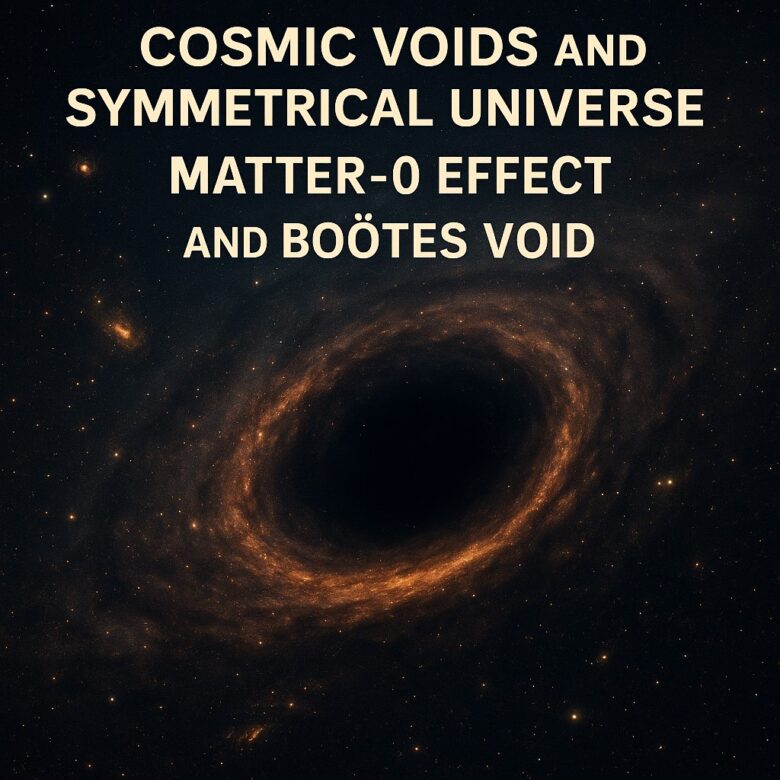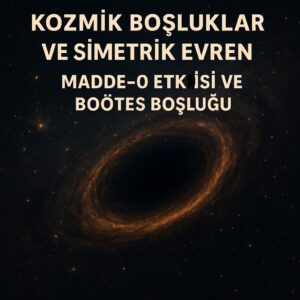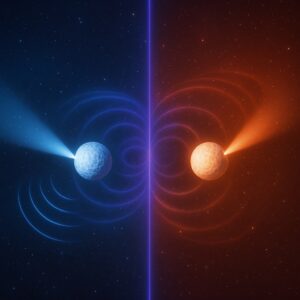Matter-0 Effect
Summary
There are vast areas in the universe that appear almost completely empty, with no galaxies: cosmic voids. These regions are much sparser than the average density of the universe and, interestingly, are expanding even faster than the overall expansion rate of the universe. Observations in recent years have revealed that these voids merge to form massive “cosmic bubbles.”
In this article, we first discuss how cosmic voids are scientifically defined using current cosmology data. Then, I offer a different interpretation based on the Symmetric Universe Model I developed and its component, the Matter-0 hypothesis: Voids may not just be empty spaces, but also traces left by matter–antimatter collisions in the early universe.
Full Text: https://unspeakingsound.com/wp-content/uploads/2025/09/Cosmic-Voids.pdf
1. What are Cosmic Voids?
Cosmic voids are enormous empty spaces in the universe where galaxies are extremely sparse, with some spanning 100–300 million light-years in diameter.
- Density Contrast (δ):
Observations show that these voids expand faster than the general expansion of the universe. For example, the Boötes Void is one of the largest known cosmic voids, with a diameter of approximately 330 Mpc, and has a density contrast in the range −0.95<δ<−0.9. These values indicate that not only gravity but also the effect of dark energy plays an important role in the evolution of voids.
2. Symmetric Universe Model and Matter-0 Hypothesis
According to the Symmetric Universe Model, the universe is defined by the coexistence of two opposing fields (Matter Universe – Universe-1 and Antimatter Universe – Universe-2). Between these two universes, there is a special type of intermediate matter called Matter-0.
- Matter-0 exhibits only gravitational interaction and does not interact with electromagnetic waves.
- When matter and antimatter collided in the early universe, they annihilated each other, and the resulting Matter-0 may have condensed into a “vortex” structure at the core of voids.
- This mechanism may explain the abnormal expansion rate and potential rotational properties of some cosmic voids.
3. Observational Tests
Several methods stand out for verifying the hypothesis:
- Galaxy density maps (SDSS, DESI, LSST) → To determine the boundaries of voids and the δ value.
- Expansion rate measurements → Test the deviation of the intra-void Hubble parameter from H0.
- Gravitational lensing → Investigate whether voids leave unexpected gravitational signatures.
- CMB distortions (Planck, CMB-S4) → Search for anisotropic cold spots in void regions.
- Galaxy velocity vector analysis (GAIA, SDSS) → Measure whether voids rotate around their own axes.
- Gravitational wave survey (LISA) → Detect low-frequency waves originating from matter-0.
4. Findings and Discussion
- The standard model explains the rapid expansion of voids with dark energy dominance.
- However, some observed anomalies and resonance effects may not be explained by this model alone.
- The Matter-0 hypothesis proposes that voids carry traces of the universe’s symmetric structure and may behave gravitationally differently.
- This hypothesis offers a complementary framework to existing models; however, direct experimental evidence is not yet available.
5. Conclusion
Cosmic voids are among the most mysterious and least understood regions of the universe. While the ΛCDM model explains the general properties of voids, the Symmetric Universe Model and Matter-0 hypothesis offer a new perspective for understanding the deep structure of the universe.
In the coming years, high-resolution simulations, deep sky surveys, and gravitational wave observations may enable the testing of this hypothesis. Perhaps the universe’s darkest voids will reveal its greatest secrets.
Full Text: https://unspeakingsound.com/wp-content/uploads/2025/09/Cosmic-Voids.pdf


